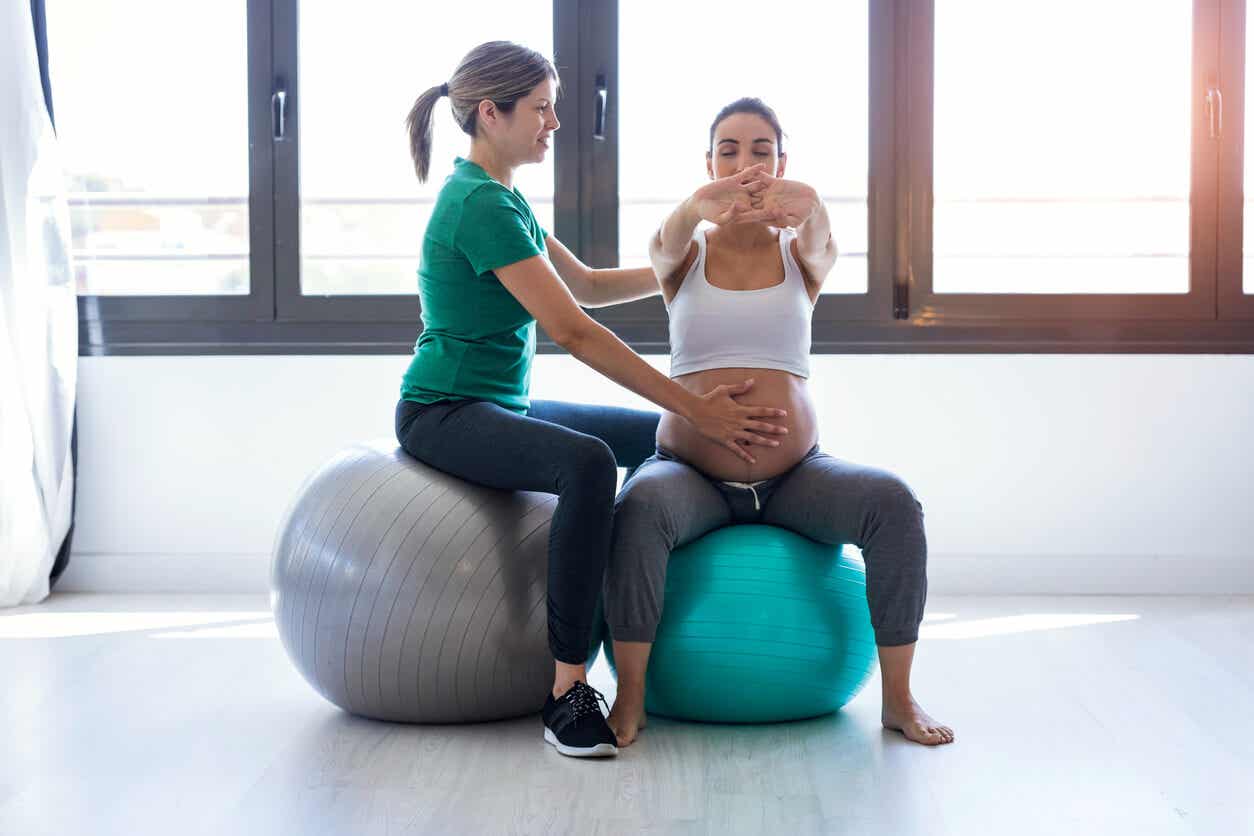5 Exercises to Recover from Childbirth as Soon as Possible


Written and verified by the physiotherapist Maria Elisa Lisotti Luppi
Going through pregnancy involves a series of physical and emotional changes in a woman’s body. After birth, all the changes that occurred during the 9 months begin to reverse. With that in mind, in this article, we’ll tell you about 5 exercises to recover from childbirth as soon as possible.
The first 6 to 8 weeks after the birth of a child, mothers need to rest as much as possible to recover the energy consumed. It’s also a stage of adaptation to the new roles of motherhood.
The well-known quarantine, for example, is a period of rest that’s necessary for the uterus to return to its original size. After these first 40 days, if your doctor authorizes it, you can begin to exercise slowly and progressively.
Remember that although the changes that the maternal body goes through are similar in all women, they won’t be the same after a vaginal delivery as after a cesarean section.
Go for a walk

Going for a walk is one of the safest activities to start exercising and recover after childbirth. You can go out alone to take a break, or you can take the opportunity to carry your baby and go for a walk together.
It’s a good idea to start with 2 outings a week, for 15 to 20 minutes, and gradually increase the frequency and duration of the walks.
During the walk, it’s helpful to be aware of your abdomen and try to tighten those muscles at all times. One way is to bring the navel toward the spine while walking. This will help you regain abdominal strength more quickly.
Walking also promotes blood circulation, improves rest, clears the mind, and produces positive changes in your mood.
Situps
The recovery of the abdominal muscles will depend on the route of birth (vaginal or cesarean).
In the first case, the improvement may occur somewhat faster than in the second. This is because, in the surgery, doctors must cut through several layers of tissues to reach the uterus. In addition, after the cesarean section, the woman will need to take some time to recover sensitivity in the wound area, which will have an impact on her abdominal strength.
Normal situps
There are many ways to do abdominal exercises. In the postpartum period, it’s important to start slowly, listen to your body, and be aware of your breathing.
Lying on your back, place a bolster under your knees. Then inhale, lifting all the air in the direction of the abdomen and exhale, “deflating” this cavity. During exhalation, it’s important to tighten the rectus abdominals. This is the first exercise to perform.
Once you feel stronger and can identify how the belly tightens, you can move on to more complex exercises. For example, placing your hands on the back of your neck and taking your shoulders off the floor.
The bicycle
Lying on your back, you must imitate pedaling with your legs as you raise your trunk, trying to make contact between the elbow on one side with the knee on the other.
Exercise ball
An exercise ball is a great element to perform exercises throughout the perinatal period. You can use it to prop your legs up while performing normal crunches.
When you regain more postural control, you can perform the crunches with your feet on the floor and your back on the ball. This will make the exercise more difficult.
Exercising the pelvic floor
In the case of cesarean births, the pelvic floor will be less affected than in vaginal births. This is because the baby stretches the pelvic musculature as it passes through the birth canal.
To exercise the pelvic floor, it’s essential that you maintain good respiratory control and be aware of the genital area. During inspiration, this area relaxes and, when you exhale, it contracts. You must hold the exhalation for at least 8 seconds, concentrating your strength on the muscles surrounding the sphincters.
This exercise can be done while sitting, standing, or lying down. You can even do it while you do another activity, such as breastfeeding your baby. You can also combine it with walking or sit-ups.
Working the pelvis

All the pelvic exercises that you did before delivery will be very useful during the postpartum period. You can sit on a pilates ball, or on a pillow, and with your knees slightly bent, make circular movements with your pelvis. You can also move by tilting your pelvis forward and backward.
Maintaining good pelvic mobility improves blood circulation in the area, which helps reduce postpartum discomfort.
Moderate cardio exercises
Cardio exercises to recover after childbirth help improve your mood and sense of satisfaction. You should start progressively, with low-intensity activities, and increase gradually.
It’s important that you don’t do high-impact exercises until your doctor says it is okay.
There’s a wide variety of cardio exercises that you can do in the postpartum period, so we recommend that you consult a professional in the area to adapt the activity to your possibilities.
Regarding exercising to recover from childbirth, remember that…
Post-birth recovery involves the healing of tissues that underwent major changes during pregnancy. Just as the uterus recovers its size and your organs regain their location, your muscles must regain their strength and functionality. Consulting a physical therapist that specializes in the pelvic floor will help guide women in their recovery.
This is a physically and emotionally complex stage, so it’s important to be patient and take it easy. Biological times must be respected, as the speed of recovery will depend on the health situation of each woman.
Going through pregnancy involves a series of physical and emotional changes in a woman’s body. After birth, all the changes that occurred during the 9 months begin to reverse. With that in mind, in this article, we’ll tell you about 5 exercises to recover from childbirth as soon as possible.
The first 6 to 8 weeks after the birth of a child, mothers need to rest as much as possible to recover the energy consumed. It’s also a stage of adaptation to the new roles of motherhood.
The well-known quarantine, for example, is a period of rest that’s necessary for the uterus to return to its original size. After these first 40 days, if your doctor authorizes it, you can begin to exercise slowly and progressively.
Remember that although the changes that the maternal body goes through are similar in all women, they won’t be the same after a vaginal delivery as after a cesarean section.
Go for a walk

Going for a walk is one of the safest activities to start exercising and recover after childbirth. You can go out alone to take a break, or you can take the opportunity to carry your baby and go for a walk together.
It’s a good idea to start with 2 outings a week, for 15 to 20 minutes, and gradually increase the frequency and duration of the walks.
During the walk, it’s helpful to be aware of your abdomen and try to tighten those muscles at all times. One way is to bring the navel toward the spine while walking. This will help you regain abdominal strength more quickly.
Walking also promotes blood circulation, improves rest, clears the mind, and produces positive changes in your mood.
Situps
The recovery of the abdominal muscles will depend on the route of birth (vaginal or cesarean).
In the first case, the improvement may occur somewhat faster than in the second. This is because, in the surgery, doctors must cut through several layers of tissues to reach the uterus. In addition, after the cesarean section, the woman will need to take some time to recover sensitivity in the wound area, which will have an impact on her abdominal strength.
Normal situps
There are many ways to do abdominal exercises. In the postpartum period, it’s important to start slowly, listen to your body, and be aware of your breathing.
Lying on your back, place a bolster under your knees. Then inhale, lifting all the air in the direction of the abdomen and exhale, “deflating” this cavity. During exhalation, it’s important to tighten the rectus abdominals. This is the first exercise to perform.
Once you feel stronger and can identify how the belly tightens, you can move on to more complex exercises. For example, placing your hands on the back of your neck and taking your shoulders off the floor.
The bicycle
Lying on your back, you must imitate pedaling with your legs as you raise your trunk, trying to make contact between the elbow on one side with the knee on the other.
Exercise ball
An exercise ball is a great element to perform exercises throughout the perinatal period. You can use it to prop your legs up while performing normal crunches.
When you regain more postural control, you can perform the crunches with your feet on the floor and your back on the ball. This will make the exercise more difficult.
Exercising the pelvic floor
In the case of cesarean births, the pelvic floor will be less affected than in vaginal births. This is because the baby stretches the pelvic musculature as it passes through the birth canal.
To exercise the pelvic floor, it’s essential that you maintain good respiratory control and be aware of the genital area. During inspiration, this area relaxes and, when you exhale, it contracts. You must hold the exhalation for at least 8 seconds, concentrating your strength on the muscles surrounding the sphincters.
This exercise can be done while sitting, standing, or lying down. You can even do it while you do another activity, such as breastfeeding your baby. You can also combine it with walking or sit-ups.
Working the pelvis

All the pelvic exercises that you did before delivery will be very useful during the postpartum period. You can sit on a pilates ball, or on a pillow, and with your knees slightly bent, make circular movements with your pelvis. You can also move by tilting your pelvis forward and backward.
Maintaining good pelvic mobility improves blood circulation in the area, which helps reduce postpartum discomfort.
Moderate cardio exercises
Cardio exercises to recover after childbirth help improve your mood and sense of satisfaction. You should start progressively, with low-intensity activities, and increase gradually.
It’s important that you don’t do high-impact exercises until your doctor says it is okay.
There’s a wide variety of cardio exercises that you can do in the postpartum period, so we recommend that you consult a professional in the area to adapt the activity to your possibilities.
Regarding exercising to recover from childbirth, remember that…
Post-birth recovery involves the healing of tissues that underwent major changes during pregnancy. Just as the uterus recovers its size and your organs regain their location, your muscles must regain their strength and functionality. Consulting a physical therapist that specializes in the pelvic floor will help guide women in their recovery.
This is a physically and emotionally complex stage, so it’s important to be patient and take it easy. Biological times must be respected, as the speed of recovery will depend on the health situation of each woman.
All cited sources were thoroughly reviewed by our team to ensure their quality, reliability, currency, and validity. The bibliography of this article was considered reliable and of academic or scientific accuracy.
- Ciria Martínez, Daniel. Diseño de un programa de ejercicio físico en el postparto para la prevención de la incontinencia urinaria. (2020).
- Acosta Salazar, Estefanía Guadalupe. Investigación bibliográfica de la aplicación de ejercicios de Kegel e hipopresivos para preservar la fuerza muscular de suelo pélvico pre y post parto. BS thesis. Quito: UCE, 2020.
- Juez-Viana, Leire. Comparación anátomo-funcional de los ejercicios hipopresivos frente al entrenamiento muscular de suelo pélvico durante el postparto. (2020).
- Nieves Mallo, Xiana. Eficacia de una intervención fisioterapéutica en la incontinencia fecal postparto: un proyecto de investigación. (2020)
- Juárez Jiménez, MªV, et al. Puntos clave en los ejercicios Kegel.
- Mostazo Guerra, Ana. Protocolo de intervención fisioterápica en la diástasis abdominal postparto. (2020).
- Franco Alcívar, Luis Marcelo. Ejercicios aeróbicos para inducir a la actividad física sistemática después del parto al personal femenino del Ala de Combate No. 21. BS thesis. Universidad de Guayaquil. Facultad de Educación Fisica Deporte y Recreación, 2018.
- Villarroya Aparicio, Adoración. Efectos de un programa de fisioterapia de suelo pélvico en un grupo de pacientes con Incontinencia Urinaria de Esfuerzo Postparto.
This text is provided for informational purposes only and does not replace consultation with a professional. If in doubt, consult your specialist.








